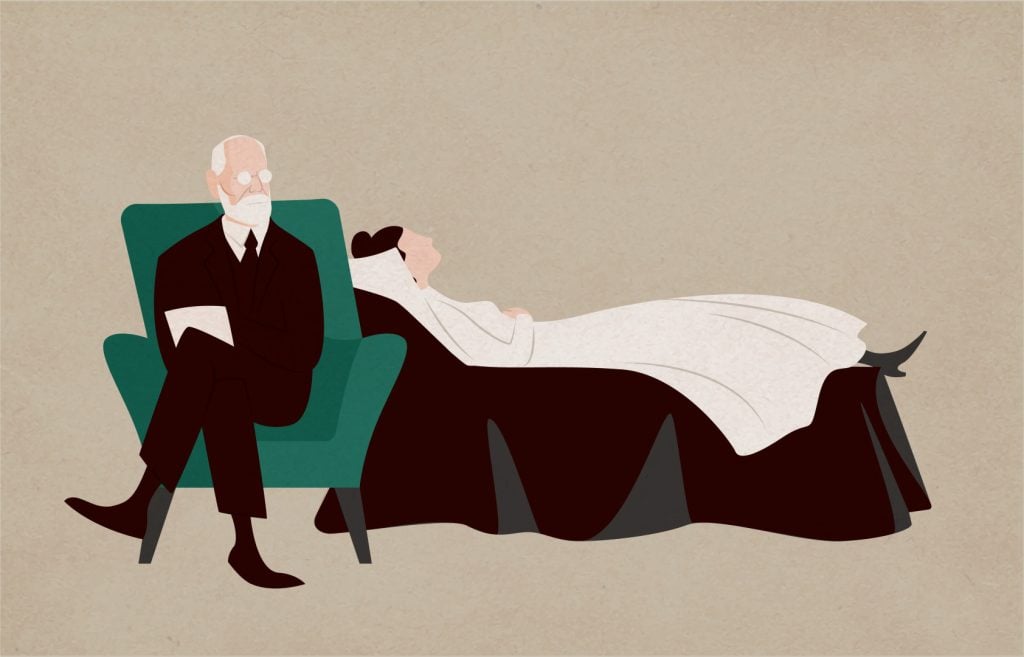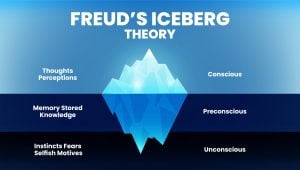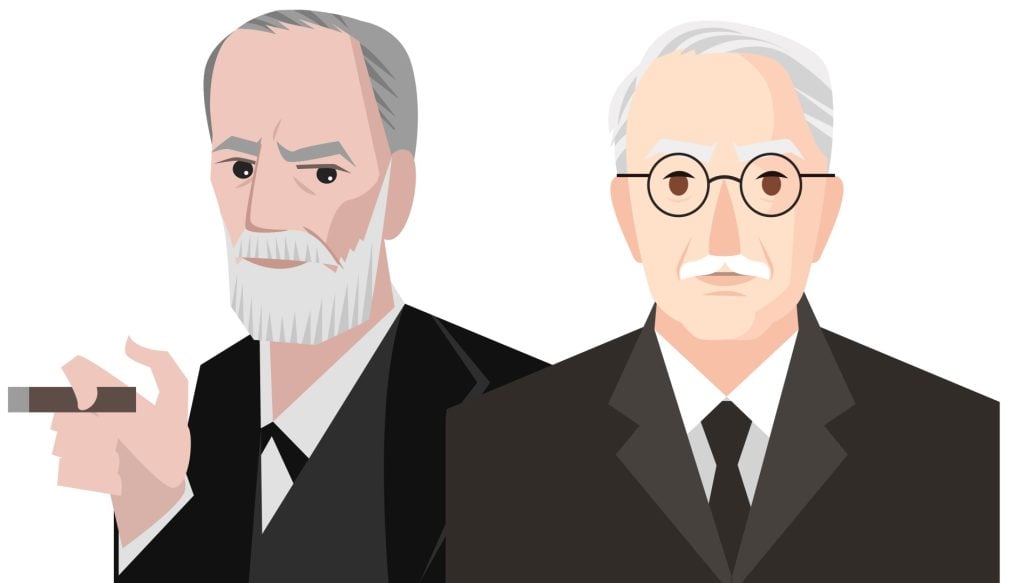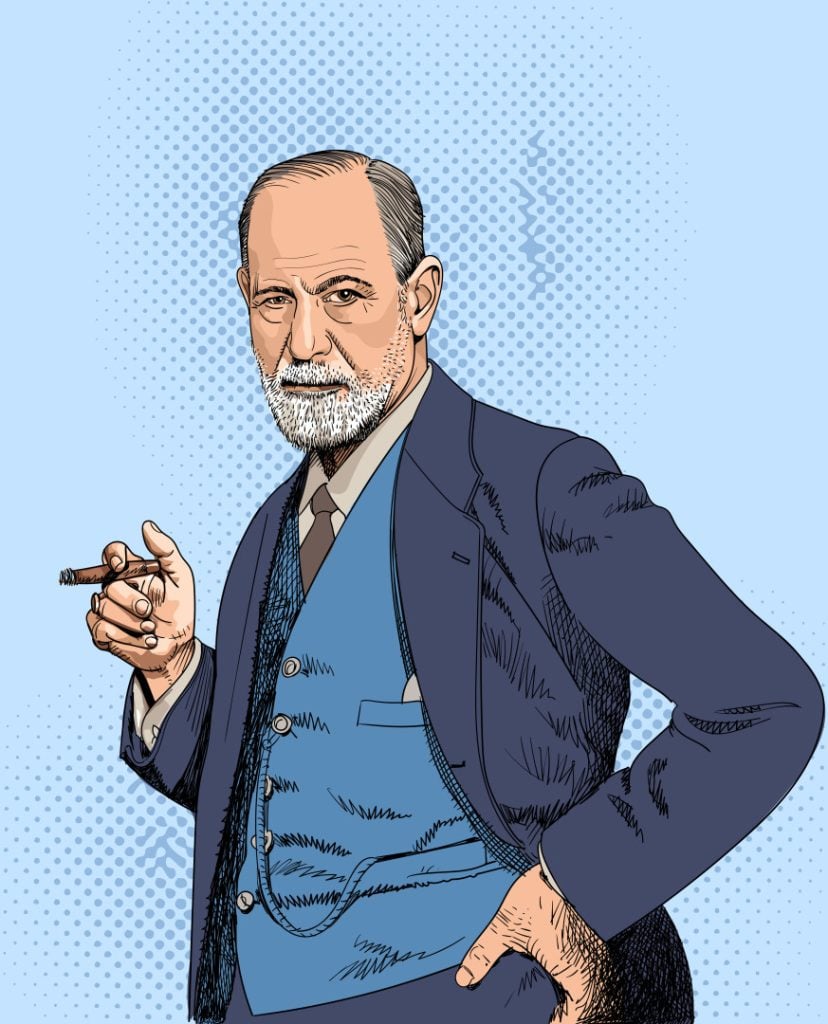
Sigmund Freud (1856 to 1939) was the founding father of psychoanalysis, a method for treating mental illness and a theory explaining human behavior.
Freud believed that events in our childhood have a great influence on our adult lives, shaping our personality. For example, anxiety originating from traumatic experiences in a person’s past is hidden from consciousness and may cause problems during adulthood (neuroses).
Thus, when we explain our behavior to ourselves or others (conscious mental activity), we rarely give a true account of our motivation. This is not because we are deliberately lying. While human beings are great deceivers of others; they are even more adept at self-deception.
Freud’s life work was dominated by his attempts to penetrate this often subtle and elaborate camouflage that obscures the hidden structure and processes of personality.
His lexicon has become embedded within the vocabulary of Western society. Words he introduced through his theories are now used by everyday people, such as anal (personality), libido, denial, repression, cathartic, Freudian slip, and neurotic.
Who is Sigmund Freud
Sigmund Freud, born on May 6, 1856, in what is now Příbor, Czech Republic (then part of the Austrian Empire), is hailed as the father of psychoanalysis. He was the eldest of eight children in a Jewish family.
Freud initially wanted to become a law professional but later developed an interest in medicine. He entered the University of Vienna in 1873, graduating with an MD in 1881. His primary interests included neurology and neuropathology. He was particularly interested in the condition of hysteria and its psychological causes.
In 1885, Freud received a grant to study with Jean-Martin Charcot, a renowned neurologist who used hypnosis to treat women suffering from what was then called “hysteria.” This experience sparked Freud’s interest in the unconscious mind, a theme that would recur throughout his career.
In 1886, Freud returned to Vienna, married Martha Bernays, and set up a private practice to treat nervous disorders. His work during this time led to his revolutionary concepts of the human mind and the development of the psychoanalytic method.
Freud introduced several influential concepts, including the Oedipus complex, dream analysis, and the structural model of the psyche divided into the id, ego, and superego. He published numerous works throughout his career, the most notable being “The Interpretation of Dreams” (1900), “The Psychopathology of Everyday Life” (1901), and “Three Essays on the Theory of Sexuality” (1905).
Despite controversy and opposition, Freud continued to develop his theories and expand the field of psychoanalysis. He was deeply affected by the outbreak of World War I and later by the rise of the Nazis in Germany. In 1938, due to the Nazi threat, he emigrated to London with his wife and youngest daughter.
Freud died in London on September 23, 1939, but his influence on psychology, literature, and culture remains profound and pervasive.
He radically changed our understanding of the human mind, emphasizing the power of unconscious processes and pioneering therapeutic techniques that continue to be used today.
Sigmund Freud’s Theories & Contributions
-
Psychoanalytic Theory: Freud is best known for developing psychoanalysis, a therapeutic technique for treating mental health disorders by exploring unconscious thoughts and feelings.
-
Unconscious Mind: Freud (1900, 1905) developed a topographical model of the mind, describing the features of the mind’s structure and function. Freud used the analogy of an iceberg to describe the three levels of the mind.

An illustration of Freud’s Iceberg Theory, where the conscious mind is the visible tip above the water, while the larger unconscious mind lies submerged, out of immediate sight yet immensely influential. - Personality: Freud proposed a tripartite model of the human mind, composed of the id, ego, and superego. The id represents primal desires, the ego balances the id and reality, and the superego represents societal norms and morals.
The id, ego, and superego have most commonly been conceptualized as three essential parts of the human personality.
-
Psychosexual Development: Freud’s controversial theory of psychosexual development suggests that early childhood experiences and stages (oral, anal, phallic, latency, and genital) shape our adult personality and behavior.
His theory of psychosexual stages of development is predicated by the concept that childhood experiences create the adult personality and that problems in early life would come back to haunt the individual as a mental illness.
-
Dream Analysis: Freud believed dreams were a window into the unconscious mind and developed methods for analyzing dream content for repressed thoughts and desires.
Dreams represent unfulfilled wishes from the id, trying to break through to the conscious. But because these desires are often unacceptable, they are disguised or censored using such defenses as symbolism.
Freud believed that by undoing the dreamwork, the analyst could study the manifest content (what they dreamt) and interpret the latent content ( what it meant) by understanding the symbols.
-
Defense Mechanisms: Freud proposed several defense mechanisms, like repression and projection, which the ego employs to handle the tension and conflicts among the id, superego, and the demands of reality.
Sigmund Freud’s Patients
Sigmund Freud’s clinical work with several patients led to major breakthroughs in psychoanalysis and a deeper understanding of the human mind. Here are summaries of some of his most notable cases:
-
Anna O. (Bertha Pappenheim): Known as the ‘birth of psychoanalysis,’ Anna O. was a patient of Freud’s colleague Josef Breuer. However, her case heavily influenced Freud’s thinking.
She suffered from various symptoms, including hallucinations and paralysis, which Freud interpreted as signs of hysteria caused by repressed traumatic memories. The “talking cure” method with Anna O. would later evolve into Freudian psychoanalysis.
-
Dora (Ida Bauer): Dora, a pseudonym Freud used, was a teenager suffering from what he diagnosed as hysteria. Her symptoms included aphonia (loss of voice) and a cough.
Freud suggested her issues were due to suppressed sexual desires, particularly those resulting from a complex series of relationships in her family. The Dora case is famous for the subject’s abrupt termination of therapy, and for the criticisms Freud received regarding his handling of the case.
-
Little Hans (Herbert Graf): Little Hans, a five-year-old boy, feared horses. Freud never met Hans but used information from the boy’s father to diagnose him.
He proposed that Little Hans’ horse phobia was symbolic of a deeper fear related to the Oedipus Complex – unconscious feelings of affection for his mother and rivalry with his father. The case of Little Hans is often used as an example of Freud’s theory of the Oedipal Complex in children.
-
Rat Man (Ernst Lanzer): Rat Man came to Freud suffering from obsessive thoughts and fears related to rats, a condition known as obsessional neurosis.
Freud connected his symptoms to suppressed guilt and repressed sexual desires. The treatment of Rat Man further expanded Freud’s work on understanding the role of internal conflicts and unconscious processes in mental health disorders.
-
Wolf Man (Sergei Pankejeff): Wolf Man was a wealthy Russian aristocrat who came to Freud with various symptoms, including a recurring dream about wolves.
Freud’s analysis, focusing on childhood memories and dreams, led him to identify the presence of repressed memories and the influence of the Oedipus Complex. Wolf Man’s treatment is often considered one of Freud’s most significant and controversial cases.
In the highly repressive “Victorian” society in which Freud lived and worked, women, in particular, were forced to repress their sexual needs. In many cases, the result was some form of neurotic illness.
Freud sought to understand the nature and variety of these illnesses by retracing the sexual history of his patients. This was not primarily an investigation of sexual experiences as such. Far more important were the patient’s wishes and desires, their experience of love, hate, shame, guilt, and fear – and how they handled these powerful emotions.
Freud’s Followers
Freud attracted many followers, who formed a famous group in 1902 called the “Psychological Wednesday Society.” The group met every Wednesday in Freud’s waiting room.
As the organization grew, Freud established an inner circle of devoted followers, the so-called “Committee” (including Sàndor Ferenczi, and Hanns Sachs (standing) Otto Rank, Karl Abraham, Max Eitingon, and Ernest Jones).
At the beginning of 1908, the committee had 22 members and was renamed the Vienna Psychoanalytic Society.

Neo-Freudians
The term “neo-Freudians” refers to psychologists who were initially followers of Sigmund Freud (1856 to 1939) but later developed their own theories, often modifying or challenging Freud’s ideas.
Here are summaries of some of the most notable neo-Freudians:
-
Carl Jung: Jung (1875 – 1961) was a close associate of Freud but split due to theoretical disagreements. He developed the concept of analytical psychology, emphasizing the collective unconscious, which houses universal symbols or archetypes shared by all human beings. He also introduced the idea of introversion and extraversion.
-
Alfred Adler: Adler (1870 – 1937) was another early follower of Freud who broke away due to differing views. He developed the school of individual psychology, highlighting the role of feelings of inferiority and the striving for superiority or success in shaping human behavior. He also emphasized the importance of social context and community.
- Otto Rank: Rank (1884 – 1939) was an early collaborator with Freud and played a significant role in the development of psychoanalysis. He proposed the “trauma of birth” as a critical event influencing the psyche. Later, he shifted focus to the relationship between therapist and client, influencing the development of humanistic therapies.
-
Karen Horney: Horney (1885 – 1952) challenged Freud’s views on women, arguing against the concept of “penis envy.” She suggested that social and cultural factors significantly influence personality development and mental health. Her concept of ‘basic anxiety’ centered on feelings of helplessness and insecurity in childhood, shaping adult behavior.
- Harry Stack Sullivan: Sullivan (1892 – 1949) developed interpersonal psychoanalysis, emphasizing the role of interpersonal relationships and social experiences in personality development and mental disorders. He proposed the concept of the “self-system” formed through experiences of approval and disapproval during childhood.
-
Melanie Klein: Klein (1882 – 1960), a prominent psychoanalyst, is considered a neo-Freudian due to her development of object relations theory, which expanded on Freud’s ideas. She emphasized the significance of early childhood experiences and the role of the mother-child relationship in psychological development.
- Anna Freud: Freud’s youngest daughter significantly contributed to psychoanalysis, particularly in child psychology. Anna Freud (1895 – 1982) expanded on her father’s work, emphasizing the importance of ego defenses in managing conflict and preserving mental health.
-
Wilhelm Reich: Reich (1897 – 1957), once a student of Freud, diverged by focusing on bodily experiences and sexual repression, developing the theory of orgone energy. His emphasis on societal influence and body-oriented therapy made him a significant neo-Freudian figure.
- Erich Fromm: Fromm (1900-1980) was a German-American psychoanalyst associated with the Frankfurt School, who emphasized culture’s role in developing personality. He advocated psychoanalysis as a tool for curing cultural problems and thus reducing mental illness.
-
Erik Erikson: Erikson (1902 – 1994) extended Freud’s theory of psychosexual development by adding social and cultural aspects and proposing a lifespan development model. His theory of psychosocial development outlined eight stages, each marked by a specific crisis to resolve, that shape an individual’s identity and relationships.
Critical Evaluation
Does evidence support Freudian psychology? Freud’s theory is good at explaining but not predicting behavior (which is one of the goals of science).
For this reason, Freud’s theory is unfalsifiable – it can neither be proved true or refuted. For example, the unconscious mind is difficult to test and measure objectively. Overall, Freud’s theory is highly unscientific.
Despite the skepticism of the unconscious mind, cognitive psychology has identified unconscious processes, such as procedural memory (Tulving, 1972), automatic processing (Bargh & Chartrand, 1999; Stroop, 1935), and social psychology has shown the importance of implicit processing (Greenwald & Banaji, 1995). Such empirical findings have demonstrated the role of unconscious processes in human behavior.
However, most evidence for Freud’s theories is from an unrepresentative sample. He mostly studied himself, his patients, and only one child (e.g., Little Hans).
The main problem here is that the case studies are based on studying one person in detail, and regarding Freud, the individuals in question are most often middle-aged women from Vienna (i.e., his patients).
This makes generalizations to the wider population (e.g., the whole world) difficult. However, Freud thought this unimportant, believing in only a qualitative difference between people.
Freud may also have shown research bias in his interpretations – he may have only paid attention to information that supported his theories, and ignored information and other explanations that did not fit them.
However, Fisher & Greenberg (1996) argue that Freud’s theory should be evaluated in terms of specific hypotheses rather than a whole. They concluded that there is evidence to support Freud’s concepts of oral and anal personalities and some aspects of his ideas on depression and paranoia.
They found little evidence of the Oedipal conflict and no support for Freud’s views on women’s sexuality and how their development differs from men’.
References
Bargh, J. A., & Chartrand, T. L. (1999). The unbearable automaticity of being. American psychologist, 54(7), 462.
Breuer, J., & Freud, S. (1895). Studies on hysteria. Standard Edition 2: London.
Fisher, S., & Greenberg, R. P. (1996). Freud scientifically reappraised: Testing the theories and therapy. John Wiley & Sons.
Freud, S. (1894). The neuro-psychoses of defence. SE, 3: 41-61.
Freud, S. (1896). Further remarks on the neuro-psychoses of defence. SE, 3: 157-185.
Freud, S. (1900). The interpretation of dreams. S.E., 4-5.
Freud, S. (1901). The psychopathology of everyday life. SE, 6. London: Hogarth.
Freud, S. (1905). Three essays on the theory of sexuality. Se, 7, 125-243.
Freud, S. (1915). The unconscious. SE, 14: 159-204.
Freud, S. (1920). Beyond the pleasure principle. SE, 18: 1-64.
Freud, S. (1923). The ego and the id. SE, 19: 1-66.
Freud, S. (1925). Negation. Standard edition, 19, 235-239.
Freud, S. (1961). The resistances to psycho-analysis. In The Standard Edition of the Complete Psychological Works of Sigmund Freud, Volume XIX (1923-1925): The Ego and the Id and other works (pp. 211-224).
Greenwald, A. G., & Banaji, M. R. (1995). Implicit social cognition: attitudes, self-esteem, and stereotypes. Psychological review, 102(1), 4.
Stroop, J. R. (1935). Studies of interference in serial verbal reactions. Journal of experimental psychology, 18(6), 643.
Tulving, E. (1972). Episodic and semantic memory. In E. Tulving & W. Donaldson (Eds.), Organization of Memory, (pp. 381–403). New York: Academic Press.
FAQs
What is Freud most famous for?
Why is Freud so criticized?
What did sigmund freud do?
His conceptualization of the mind’s structure (id, ego, superego), his theories of psychosexual development, and his exploration of defense mechanisms revolutionized our understanding of human psychology.
Despite controversies and criticisms, Freud’s theories have fundamentally shaped the field of psychology and the way we perceive the human mind.
What is the Freudian revolution’s impact on society?


